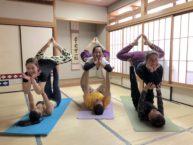For my CIP, I chose to volunteer at 京都市立京極幼稚園, a kindergarten located just three minutes away from Shōkokuji Temple near Dōshisha University. I took interest in this field as I had had previous experience working with younger children throughout my time in high school and Johns Hopkins and wanted to seize the opportunity to be able to practice my Japanese while participating in an activity I both enjoy and am familiar with. While my time at the kindergarten was curtailed in light of the outbreak of the Coronavirus, there is no doubt that the Fridays I spent playing 鬼ごっこ(tag) with the energetic four-year-olds were the highlight of my time at KCJS.
My duties as a volunteer at the kindergarten consisted mainly of two jobs: playing with the children of 花組, the class I was assigned to, and assisting the homeroom teacher in areas such as, helping the children eat lunch, getting them ready when going home, and cleaning up the classroom. While such tasks had initially seemed manageable when the 園長先生(principal) explained what I would be asked to do as a volunteer during our first meeting, executing them proved more difficult than I had imagined. What I found most challenging was ironically that I simply lacked the physical energy to keep up with the lively, tireless four-year-olds. Whenever 中田先生 would ask me how my CIP was going in the first few weeks of the semester, my answer would be 「体力が足りません」(I don’t have the physical strength or endurance). Contrary to what I had expected, playing 鬼ごっこwith seven vibrant kids proved to be difficult as they did not seem to get tired from running around constantly. However, my endurance improved with time, as I began to look forward to playing tag with them and running away from the園長先生, who was always the designated 鬼.
The most memorable moment I had during my time at the kindergarten was when I felt that the once shy children whose only method of communicating with me was to call me 皿先生 (皿means ‘plate’ in Japanese, and is pronounced the same way as サラ) began to warm up to me. Most notably, instead of designating me as the 鬼in playing tag running away from me, they would take my hand and excitedly tell me to hide with them from the teachers. This was a special moment for me, as it was the first time I felt the children were letting me into their “circle” and seeing me as one of them.
I will truly miss walking into 花組’s classroom to be greeted with seven smiling faces and energetic screams calling out, 「お皿先生!」every Friday afternoon. Being able to practice my Japanese with people of varying ages, ranging from adult teachers to whom I would speak in 敬語 (honorifics) to four-year-olds whose speech styles I was not accustomed to listening to in a classroom setting, in the kindergarten was a very rewarding experience like no other that I believe I would not have been able to have had I settled for a different CIP. While my time at 京都市立京極幼稚園 was abruptly cut short, it truly was one of the highlights of my time in Kyoto.

